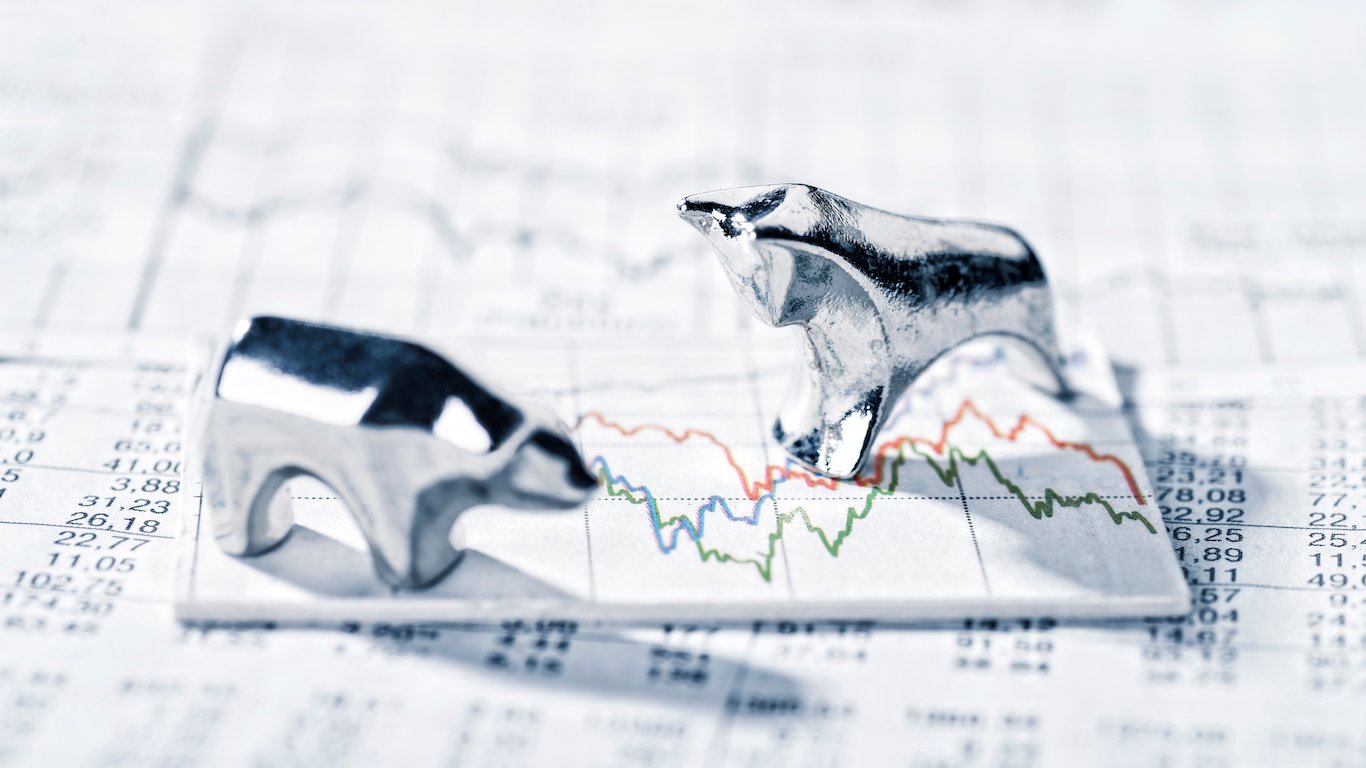

The breakdown of trade talks with China remains up for interpretation. The U.S. market reaction to tweets from President Donald Trump on Sunday was muted compared to what was seen in Asia. Also worth noting is that the markets had become less worried than they had been early in the day when traders and investors were trying to interpret the news. After preliminary indications of the Nasdaq Composite Index opening down 2%, the reaction after about 90 minutes of trading was that the Nasdaq was down less than 1%. The Dow Jones industrials and the S&P 500 were also indicated to be down about 1.7% each heading into the open, and they were each down less than 0.8% after the first 90 minutes of trading.
24/7 Wall St. has compiled a bird’s-eye view of how some reactions are coming in from the initial reports. It seems that a consensus is building that perhaps this is a last-minute tactic to get China to more readily agree to terms to avoid tariffs increasing in a few days. After all, it is widely believed that the trade impact had a far greater drag and damage in China than it did in the United States.
The Hang Seng (Hong Kong) closed down 2.9% on Monday and the SSE Composite (Shanghai) down a sharper 5.58% on Monday.
Several firms have already issued updates on how they view the tweets and the implications to Sunday’s tweets. The tweets from @realDonaldTrump on Sunday:
….of additional goods sent to us by China remain untaxed, but will be shortly, at a rate of 25%. The Tariffs paid to the USA have had little impact on product cost, mostly borne by China. The Trade Deal with China continues, but too slowly, as they attempt to renegotiate. No!
— Donald J. Trump (@realDonaldTrump) May 5, 2019
Here are some reactions from Wall Street research firms.
Citigroup has warned that the concerns about trade protectionism affecting global growth and corporate earnings had turned into complacency. The firm noted that a sharp sell-off in China suggested that equities had been pricing in a deal getting done and that the mindset is moving to doubt. Still, the firm expects a deal of some sort to be reached, with the odds of a deal higher than nothing getting done as it is in the best interest of both countries.
Goldman Sachs sees tariff increases being bad for retailers. That said, it sees only a 40% chance of the tariffs actually increasing. According to the firm, many retailers had already made changes to their orders to mitigate potential tariff increase to 25%, but some of those actions may have been put on hold due to the reported progress that had been made in trade talks. Goldman Sachs noted that tariffs are particularly bad for sectors exposed to furniture or retailers with fixed price points.
RBC Capital Markets sees the developments as a negative catalyst for the market. On top of where investor expectations had been regarding the likelihood of a successful deal, the downward earnings revisions that would occur if the tariffs are expanded would add to the mindset that profit-taking already was taking some hold.
UBS has warned that the president’s tweets could cause trade talks to break down, and the recent move would make it difficult for trade talks to easily be rekindled where the left off.
Merrill Lynch noted that at least one part of the story is that economic and market strength has reduced the incentive by both sides to compromise. The firm also noted that when policy is very responsive to markets, the policy/markets equilibrium can be elusive and the result is increased volatility. Their report noted:
First, traditional policy typically responds primarily to economic shocks. By contrast the current US administration has been very sensitive to the markets. We think this could lead to more frequent policy shifts because markets are more volatile than the underlying economy. Second, the markets understand the traditional policy response function and price it in before the fact. But if countercyclical policy shocks are not fully anticipated, as has arguably been the case with trade policy, very responsive policy increases market volatility. We show that in this case markets and policy tend to spiral away from equilibrium until the markets learn to internalize the policy response function.
The immediate market response suggests that the latest escalation of the trade war was a complete surprise to investors. This means that markets could be in for a bumpy ride before a trade deal is reached.
Even prior to the Sunday increased pressure, JPMorgan had been cautious on China’s relationship with the United States. After both sides acknowledged that much work remains to be done, that longer-term cautious view said on April 30:
In the long run, the U.S.-China relationship is unlikely to go back to the old days. We expect the competition between the two economic superpowers, in areas of trade, technology, and geopolitical influence to become a new normal. … Whether a deal is reached or not, the U.S.-China relationship has changed fundamentally. While a tariff war would have a more immediate impact that could accelerate the pace of relocation, conflict in non-tariff areas still increases uncertainty in the trade and business environment and may continue to support the relocation trend in the long run.
The two key exchange-traded funds that track China also recovered from their lows seen earlier in the morning.
The iShares China Large-Cap ETF (NYSEARCA: FXI) was last seen trading down 2.9% at $43.60 Monday morning, but it had opened down at $43.19. Its 52-week range is $37.85 to $48.93. This fund was designed to track the performance of the FTSE China 50 Index, which is made up of the large-capitalization Chinese equities that trade on the Hong Kong Stock Exchange.
The Xtrackers Harvest CSI 300 China A-Shares ETF (NYSEARCA: ASHR) was last seen down 5.5% at $27.60, though it had opened at $27.23. Its 52-week range is $21.51 to $31.03. This fund was designed to track the performance of the China A-Share market and is made up of the 300 largest and most liquid stocks in that market.
Thank you for reading! Have some feedback for us?
Contact the 24/7 Wall St. editorial team.
 24/7 Wall St.
24/7 Wall St.


